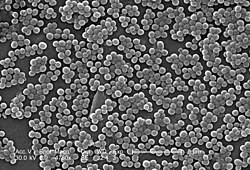| Staphylococcus aureus ST8:USA300 | |
|---|---|
 | |
| Electron micrograph of MRSA | |
| Scientific classification | |
| Domain: | Bacteria |
| Kingdom: | Bacillati |
| Phylum: | Bacillota |
| Class: | Bacilli |
| Order: | Bacillales |
| Family: | Staphylococcaceae |
| Genus: | Staphylococcus |
| Species: | S. aureus |
| Strain: | S. a. ST8:USA300 |
| Trionomial name | |
Staphylococcus aureus ST8:USA300 | |
ST8:USA300 is a strain of community-associated methicillin-resistant Staphylococcus aureus (MRSA) that has emerged as a particularly antibiotic resistant epidemic that is responsible for rapidly progressive, fatal diseases including necrotizing pneumonia, severe sepsis and necrotizing fasciitis. [1]
The epidemiology of infections caused by MRSA is rapidly changing: in the past 10 years, infections caused by this organism have emerged in the community (whereas previously MRSA infections were almost exclusively hospital-acquired). The two MRSA clones in the United States most closely associated with community outbreaks, USA400 (MW2 strain, ST1 lineage) and USA300, often contain Panton-Valentine leukocidin (PVL) genes and, more frequently, have been associated with skin and soft tissue infections.
Outbreaks of community-associated (CA)-MRSA infections have been reported in correctional facilities, among athletic teams, among military recruits, in newborn nurseries, and among sexually active men who have sex with men, CA-MRSA infections now appear to be endemic in many urban regions and cause most MRSA infections. [2] [3]